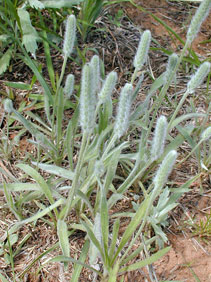WOOLLY PLANTAIN
|
 |
| File Size: 138 KB |
|
|
|
Plantago patagonica Jacq.
|
| Smith County, Kansas |
| Annual |
| Height: 2-12 inches |
| Family: Plantaginaceae - Plantain Family |
| Flowering Period: May, June, July |
|
| Also Called: | | Patagonian plantain, woolly indianwheat. | | Stems: | | Nearly stemless or .5 to 1.5 inch long from 2- to 4-branched caudex. | | Leaves: | | Alternate, basal, simple, ascending, linear-oblanceolate, 1 to 8 inches long, about 1/2 inch wide; veins 1-3; margins entire; surfaces woolly-hairy; tips pointed. | | Inflorescences: | | Spike, narrow, 1 to 6 inches long, densely woolly or silky pubescent, terminal on stalk 1 to 10 inches long; 1-20 spikes per plant. | | Flowers: | | Inconspicuous, densely crowded in spike; covering bracts triangular to linear, less than 1/10 inch long, progressively reduced above, woolly pubescent; petals 4, whitish; stamens 4, slightly protruding to included. | | Fruits: | | Capsule, opening near middle; seeds 2, boat-shaped, light brown, about 1/12 inch long. | | Habitat: | | Dry prairies, pastures, waste places, and roadsides; all soil types, but more abundant on sandy or rocky soils. | | Distribution: | | Throughout Kansas, but more frequently in west 2/3. | | Forage Value: | | A food source for birds and small mammals. | | Uses: | | Native Americans used a tea brewed from the plant as an appetite supressant and to treat headaches and diarrhea. They used the seeds for food. | | Comments: | | Woolly plantain is drought resistant. It is not a problem weed or a significant forage plant. The presence of woolly plantain can be an indicator of overgrazing. The pollen is thought to cause allergy symptoms. |
|
| Woolly plantain inflorescences, flowers and anthers |  | | 78 KB | | Smith County, Kansas |
| | Woolly plantain |  | | 118 KB | | Finney County, Kansas |
| | | |
|
|
|
|
|
|




